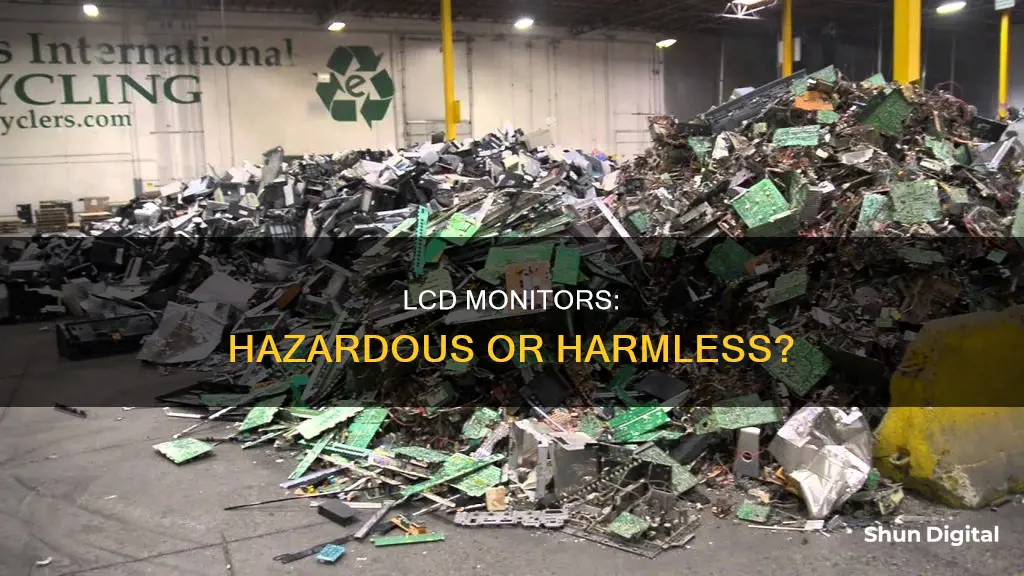
Liquid Crystal Displays (LCDs) are a type of screen used in TVs, computers, mobile phones, tablets, and other devices. They are popular because they are thin, lightweight, and consume less power than Cathode Ray Tube (CRT) displays. However, there are concerns about the potential hazards and environmental impact of LCDs, especially when they are discarded.
LCD screens contain various chemicals and toxic metals, such as mercury, lead, arsenic, and cadmium, which can pose a danger to human health and the environment if not properly handled and recycled. For example, if the mercury-containing backlight tube of an LCD screen is cracked, it can leak mercury vapour, which is hazardous. Additionally, the manufacturing process of LCDs can release harmful substances, such as sulfur hexafluoride and hydrochloric acid, contributing to global warming and acid rain.
While LCD screens have improved energy efficiency compared to CRTs, their widespread use still consumes a significant amount of energy, especially when electricity is derived from non-renewable sources. Furthermore, the disposal of LCD monitors can lead to solid waste generation and the release of toxic substances into the environment if not properly managed.
| Characteristics | Values |
|---|---|
| Positives | Consumes less power, lighter and thinner than CRT displays, doesn't emit UV or blue light |
| Negative Health Effects | Over-exposure to electromagnetic fields above two milligauss (mG) can cause muscle ache, insomnia, fatigue, cancer, burning eyes, headaches, skin burns, dry and wrinkled skin |
| Negative Environmental Effects | Contribute to solid waste generation, considered hazardous material as they contain toxic substances, e.g. mercury, use of hydro-fluorocarbons can deplete the ozone layer, manufacturing process releases nitric oxides, hydrochloric acid and hydrofluoric acid (which causes acid rain), use of sulfur hexafluoride contributes to global warming |
| Repairability | Cannot be repaired if cracked |
| Disposal | Should be given to electronic collection stations for professionals to handle |
| Leakage | Very rare for liquid to leak out, but if it does, wash your hands with soap and water |
| Toxicity | Toxicity is minimal, but if ingested or inhaled, toxic chemicals can build up in the body over time with toxic effects |
| Mercury | Mercury-containing backlight tube can leak mercuric vapour which is hazardous to human and animal health in the long term |
What You'll Learn

Leaking LCD screens
LCD screens are not known to leak, but in the rare event that they do, it is important to take the necessary precautions. While the liquid crystal material used in LCD screens is not highly toxic, it can cause skin irritation and should not be ingested or inhaled. If you come into contact with the liquid, wash your hands thoroughly with soap and water, and if it is ingested or inhaled, seek medical assistance immediately.
In the case of a cracked LCD screen, it is unlikely that any liquid will leak out due to the presence of a plastic membrane that encloses the liquid crystal material. However, if the backlight tube is cracked, it can leak mercuric vapour, which is hazardous to human and animal health. Therefore, if your LCD screen is cracked and no longer backlighting, it is important to dispose of it properly by wrapping it in plastic and taking it to a specialised recycler.
Some LCD screens may contain toxic metals and salts, including mercury, which can cause allergic reactions, skin rashes, and even birth defects. However, this is more common in older LCD screens, and modern screens often use LED backlights instead of mercury-containing CCFL backlights.
It is important to note that LCD screens should not be burned, as the vapours released can be hazardous. If you need to dispose of an old LCD monitor or TV, take it to an electronic collection station where professionals can handle it safely and recycle any retrievable materials.
Monitoring App Data Usage: A Comprehensive Guide
You may want to see also

Toxic vapours
It is important to note that modern LCD manufacturers have largely shifted to using LED backlights, which do not contain mercury. However, it is still crucial to handle a cracked or damaged LCD screen with caution. If you notice any leakage or an unusual smell coming from the cracked area, it is recommended to remove the screen from your home or office and dispose of it properly through specialised recycling services.
In addition to the potential release of toxic vapours, LCD monitors can also contribute to environmental concerns in other ways. The manufacturing process of LCD monitors can release harmful substances such as sulfur hexafluoride, nitric oxides, hydrochloric acid, and hydrofluoric acid, which contributes to global warming and acid rain. Furthermore, the disposal of discarded LCD monitors is also a concern, as they contain toxic substances like mercury, arsenic, lead, and cadmium. Improper disposal of these monitors can lead to the release of these toxic substances into the environment, posing risks to human health and ecological systems.
HP Pavilion Monitor Sizes: A Comprehensive Guide
You may want to see also

Mercury poisoning
Forms of Mercury Exposure
Mercury exposure can occur in the following forms:
- Metal
- Vapor
- Salt
- Organic compound
Symptoms of Mercury Poisoning
The symptoms of mercury poisoning depend on the type, dose, method, and duration of exposure. Some common symptoms include:
- Muscle weakness
- Poor coordination
- Numbness in the hands and feet
- Skin rashes
- Anxiety
- Memory problems
- Trouble speaking, hearing, or seeing
- Peripheral neuropathy
- Skin discoloration (pink cheeks, fingertips, and toes)
- Swelling
- Desquamation (shedding or peeling of skin)
- Emotional changes (mood swings, irritability, nervousness, excessive shyness)
- Neuromuscular changes (weakness, muscle atrophy, twitching)
- Disturbances in sensations
- Changes in nerve responses
- Poor performance on tests of mental function
- Kidney problems
- Decreased intelligence
- Kidney dysfunction (e.g., Fanconi syndrome)
- Neuropsychiatric symptoms (emotional lability, memory impairment, insomnia)
- Red cheeks, nose, and lips
- Loss of hair, teeth, and nails
- Transient rashes
- Hypotonia (muscle weakness)
- Increased sensitivity to light
Treatment and Prevention of Mercury Poisoning
Treatment for mercury poisoning may include chelation therapy, depending on the type and severity of exposure. Prevention of mercury poisoning involves reducing or eliminating exposure to mercury and mercury compounds. This can be achieved through dietary changes, removing mercury from medical devices, proper disposal of mercury, and avoiding further mining of mercury.
Choosing the Right Rope Size for Monitor Windvane
You may want to see also

Arsenic poisoning
Arsenic is a naturally occurring chemical element and the 20th most common on Earth. It is highly toxic in its inorganic form and can cause arsenic poisoning (or arsenicosis) in humans. Arsenic poisoning is a medical condition that occurs due to elevated levels of arsenic in the body.
Symptoms of Arsenic Poisoning
The symptoms of arsenic poisoning depend on the duration of exposure. If arsenic poisoning occurs over a brief period, symptoms may include vomiting, abdominal pain, encephalopathy, and watery diarrhea that contains blood. Long-term exposure can result in thickening of the skin, darker skin, abdominal pain, diarrhea, heart disease, numbness, and cancer.
The immediate symptoms of acute arsenic poisoning include vomiting, abdominal pain and diarrhoea. These are followed by numbness and tingling of the extremities, muscle cramping and death, in extreme cases.
The first symptoms of long-term exposure to high levels of inorganic arsenic are usually observed in the skin and include pigmentation changes, skin lesions and hard patches on the palms and soles of the feet (hyperkeratosis).
Other adverse health effects that may be associated with long-term ingestion of inorganic arsenic include developmental effects, diabetes, pulmonary disease and cardiovascular disease. Arsenic-induced myocardial infarction, in particular, can be a significant cause of excess mortality.
Causes of Arsenic Poisoning
The most common reason for long-term exposure to arsenic is contaminated drinking water. Groundwater often becomes contaminated naturally, but contamination may also occur from mining or agriculture. Arsenic may also be found in the soil and air.
People are exposed to elevated levels of inorganic arsenic through drinking contaminated water, using contaminated water in food preparation and irrigation of food crops, industrial processes, eating contaminated food and smoking tobacco.
Diagnosis and Treatment
Diagnosis is by testing the urine, blood, or hair. Prevention is by using water that does not contain high levels of arsenic, which may be achieved by the use of special filters or rainwater.
There is not good evidence to support specific treatments for long-term poisoning. For acute poisonings, treating dehydration is important. Dimercaptosuccinic acid or dimercaptopropane sulfonate may be used while dimercaprol (BAL) is not recommended. Hemodialysis may also be used.
Populations at Risk
The general population may be exposed to arsenic if they live in areas where arsenic contaminates groundwater or wells. Wooden decks and play areas constructed out of wood treated with arsenic-based preservatives prior to 2004 have been shown to increase the risk of exposure through contamination of the surrounding soil, direct contact, or during renovation or repair.
Workers in industries that use inorganic arsenic and its compounds, including wood preservation, glass production, the production of nonferrous metal alloys, and electronic semiconductor manufacturing, are at the highest risk for exposure to arsenic.
Monitoring Snapchat: A Guide for Parents
You may want to see also

Disposal and recycling
LCD monitors are considered hazardous waste and should be disposed of responsibly. If you have a cracked LCD monitor, it is important to act quickly to reduce the risk of exposure to any toxic substances. If the screen is still lighting up, then the backlight tube is likely intact. However, if the screen is no longer illuminated, the tube may be cracked, and you should take immediate action to remove it from your home or office. Wrap the monitor in plastic to contain any toxins and either put it on the curb for a specialist recycler or take it to a recycling centre that accepts LCD displays.
LCD screens do not contain hazardous components, except for the backlight tube, which may contain mercury. If this tube is cracked, it will leak mercuric vapour, which is hazardous to human and animal health. If you notice any leaking, strange smells, or a non-functioning backlight, act quickly to remove the screen from your home.
The liquid crystals themselves are mildly toxic and can cause skin irritation, so take care to avoid contact with them. Wash your hands thoroughly with soap and water if you come into contact with them.
LCD monitors contain other toxic metals, including arsenic, lead, cadmium, and chromium. These metals are present in the two glass sheets that make up the LCD panel. It is important to dispose of LCD monitors properly to prevent these toxic metals from leaching into the environment.
The EU has specific directives in place to regulate the disposal and recycling of electronic waste, including LCD monitors. These directives aim to reduce the environmental impact of this waste and protect human health.
When disposing of an LCD monitor, always follow local guidelines for electronic waste disposal and recycling. Contact your local waste management company for specific instructions on how to properly dispose of or recycle your LCD monitor.
Tightening Your ASUS VG248 Monitor Board: A Step-by-Step Guide
You may want to see also
Frequently asked questions
LCD screens do not contain hazardous components and are not considered hazardous waste, except for the mercury-containing backlight tube. If the backlight tube is cracked, it will leak mercury vapour, which is hazardous to human and animal health.
LCD monitors emit low levels of radiation, which can negatively impact human health. Over-exposure to electromagnetic fields above two milligauss (mG) can lead to muscle aches, insomnia and fatigue. Prolonged exposure may also cause cancer in humans and animals. Increased brightness or luminescence of LCD displays can result in burning eyes and headaches.
While LCD monitors consume less energy than older models, the accumulation of millions of LCD monitors in use contributes to a significant amount of energy consumption. In locations where electricity is derived from non-renewable sources, the use of LCD monitors may contribute to solid waste generation. Discarded LCD monitors are considered hazardous material as they contain toxic substances, including mercury.
If your LCD monitor is cracked and leaking, it should be removed from your home and given to a specialist recycler. Do not attempt to repair a cracked LCD monitor.







